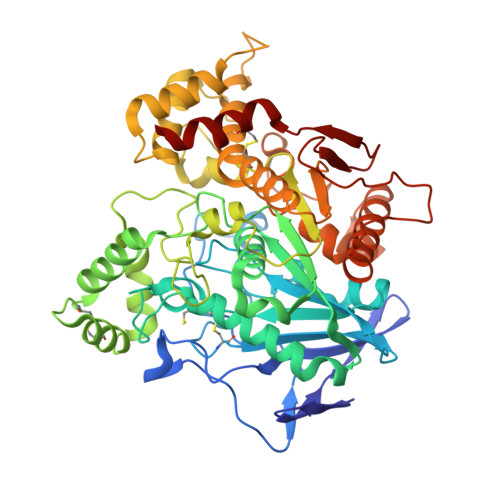Role of Water in Aging of Human Butyrylcholinesterase Inhibited by Echothiophate: The Crystal Structure Suggests Two Alternative Mechanisms of Aging
Nachon, F., Asojo, O.A., Borgstahl, G.E.O., Masson, P., Lockridge, O.(2005) Biochemistry 44: 1154-1162
- PubMed: 15667209
- DOI: https://doi.org/10.1021/bi048238d
- Primary Citation of Related Structures:
1XLU, 1XLV, 1XLW - PubMed Abstract:
Organophosphorus poisons (OP) bind covalently to the active-site serine of cholinesterases. The inhibited enzyme can usually be reactivated with powerful nucleophiles such as oximes. However, the covalently bound OP can undergo a suicide reaction (termed aging) yielding nonreactivatable enzyme. In human butyrylcholinesterase (hBChE), aging involves the residues His438 and Glu197 that are proximal to the active-site serine (Ser198). The mechanism of aging is known in detail for the nerve gases soman, sarin, and tabun as well as the pesticide metabolite isomalathion. Aging of soman- and sarin-inhibited acetylcholinesterase occurs by C-O bond cleavage, whereas that of tabun- and isomalathion-inhibited acetylcholinesterase occurs by P-N and P-S bond cleavage, respectively. In this work, the crystal structures of hBChE inhibited by the ophthalmic reagents echothiophate (nonaged and aged) and diisopropylfluorophosphate (aged) were solved and refined to 2.1, 2.25, and 2.2 A resolution, respectively. No appreciable shift in the position of the catalytic triad histidine was observed between the aged and nonaged conjugates of hBChE. This absence of shift contrasts with the aged and nonaged crystal structures of Torpedo californica acetylcholinesterase inhibited by the nerve agent VX. The nonaged hBChE structure shows one water molecule interacting with Glu197 and the catalytic triad histidine (His438). Interestingly, this water molecule is ideally positioned to promote aging by two mechanisms: breaking either a C-O bond or a P-O bond. Pesticides and certain stereoisomers of nerve agents are expected to undergo aging by breaking the P-O bond.
Organizational Affiliation:
The Eppley Institute for Research in Cancer and Allied Diseases, University of Nebraska Medical Center, Omaha, Nebraska 68198-6805, USA. florian@nachon.net























